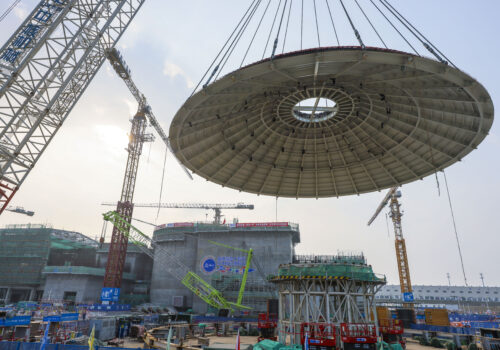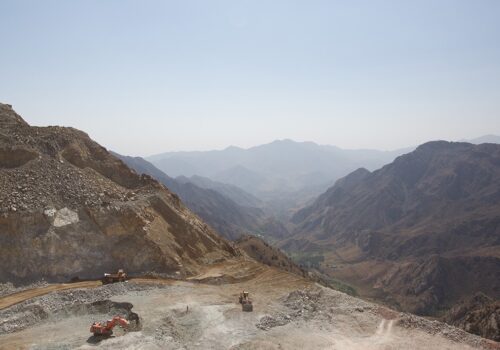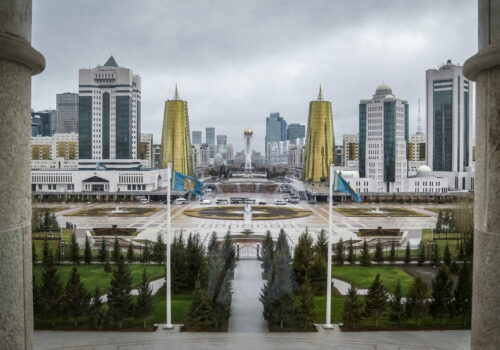How Kazakhstan can anchor a resilient rare‑earth supply chain for the West
The rare-earth supply crunch underscores a critical lesson: The United States cannot afford to rely on China’s goodwill for minerals essential to its economy and security.
China dominates the rare-earth supply chain, with Beijing supplying about 60 percent of global rare-earths output and controlling up to 90 percent of refining capacity. For the United States, which needs neodymium and dysprosium for F‑35 fighter jet engines as badly as it needs lithium for electric vehicles, continued dependence on Beijing is impossible. The solution is not wishful “onshoring” to the United States alone; it is establishing a portfolio of reliable partners. Kazakhstan, already the world’s leading uranium producer and a top‑ten copper and zinc exporter, is a prime candidate for such a partnership.
Rare earths have become a geopolitical flashpoint. In practice, that means Beijing can throttle supply at will. In April, for example, China abruptly restricted exports of several important rare earths and permanent magnets—actions triggered by trade disputes with the United States under the pretext of “energy security.” US firms and strategists described the move as China’s latest attempt to weaponize its rare-earths dominance.
Supply shocks will recur, not recede. After Beijing halted exports of rare-earth refining technology to the United States in late 2023, it spent 2024 steadily ratcheting up export-license requirements on strategic rare-earth oxides or outright banning its exports. These moves culminated in April of this year, with Beijing placing export restrictions on seven heavy and medium rare-earth elements (samarium, gadolinium, terbium, dysprosium, lutetium, scandium, and yttrium) on dual-use national-security grounds.
The United States has only just begun to free its high-tech supply chain dependence on China. Over the past few years, for example, US policymakers have launched some domestic projects and lured allies in Europe and Australia to develop alternatives, but many of those efforts are still nascent. New supply lines will take years to mature. Washington needs a long-term partnership strategy that goes beyond homespun mining; it needs countries capable of supplying rare earths at scale. Since 2020, Kazakhstan has ramped up rare-earth mining, increasing its exports nearly fivefold by 2024. Still, both in 2023 and 2024, 100 percent of its rare-earth output is exported to China—a telling indicator that the resource is there, but does not currently flow to the West. By moving swiftly, the United States could hedge against future Chinese disruptions—and help build a secure, diversified global supply chain for these critical minerals.
Kazakhstan’s rare earths
Unlike some prospective supplier countries, Kazakhstan already knows it has rare-earth wealth. In early April, geologists in the country announced the “Zhana Kazakhstan” discovery: an estimated twenty million metric tons of rare-earths‑bearing ore in the Karagandy region, including sizable heavy‑rare‑earth concentrations. If even 10 percent of the ore proves recoverable at today’s grades, that equates to around 200,000 tons of rare-earth oxide content—enough to meet current US neodymium magnet demand for a dozen years. If validated, the site would give Kazakhstan the world’s third‑largest rare-earth element reserves, trailing only China and Brazil. While promising, these preliminary findings are no sure thing and will require deeper study.
This find is not an outlier. Soviet‑era data and recent airborne surveys point to additional prospects across southern and eastern Kazakhstan. The geology has been there; what was missing was investor certainty. That is changing fast. In just the past few years, the government has opened scores of new exploration projects.
Kazakhstan is no newcomer to big mining. In 2024, the country led the world in uranium output (about 38 percent of global supply) and ranked among the top ten producers of copper and zinc. The national mining concern, Tau-Ken Samruk, consolidates dozens of mines and has global joint ventures in everything from gold to base metals. Kazakhstan’s energy and transport infrastructure likewise favors large-scale mining, as it already accounts for 14 percent of the country’s gross domestic product.
Kazakhstan’s “multivector” diplomacy also plays a factor. Kazakh President Kassym-Jomart Tokayev courts Beijing and Moscow, yet he also seeks deeper ties with Washington and Brussels to balance against those giants. That instinct makes Astana a willing partner for the United States, and a less risky one than conflict-scarred alternatives such as Myanmar and the Democratic Republic of the Congo. At the same time, the United States should not expect Kazakhstan to choose only Western partners over the major powers along its eastern and northern borders.
Since 2018, Astana has overhauled its subsoil code on a “first come, first served” model. New legislation helps promote fiscal stability, offers value-added tax holidays on exploration equipment, and caps royalties. As a result, majors from Rio Tinto to Fortescue have launched joint ventures, while US‑backed Cove Capital began drilling rare-earths targets near Arkalyk in 2024.
Kazakhstan also has an edge in infrastructure. The Middle Corridor rail‑and‑port network—which runs from western China through Kazakhstan to the Caspian Sea and onward to Europe—was expanded last year with European Union (EU) financing. Aktau’s Caspian port already handles uranium concentrate bound for Canada and France; rare-earths concentrates could follow the same route with minimal modification.
In short, Kazakhstan offers what many mining countries do not: favorable geology and the business environment and infrastructure to exploit it. Kazakhstan already has smelters and refineries for many ores, and it boasts production of advanced materials such as purified manganese sulfate and titanium metal. It even produces gallium (used in semiconductors) and recycles rhenium, though admittedly it still lacks deep processing for rare-earth oxides.
The way forward
Washington has learned the hard way that pledges alone won’t break Beijing’s monopoly, and its next move should elevate quiet deals into an explicit strategy. On the Kazakh side, top leaders have made it clear that developing mining for Western markets is a priority. For example, Tokayev has called critical minerals the country’s “new oil,” and he has signed a number of memoranda with foreign partners on exploration and processing. Kazakhstan’s September 2024 “Kazakh-German” forum alone produced twenty-three agreements in mining, including rare-earth joint ventures.
Here are the three critical steps Washington and Astana should take next:
- Unlock normal trade by repealing the Jackson-Vanik Amendment and grant Permanent Normal Trade Relations (PNTR) to Kazakhstan. The United States should finish what H.R. 1024 has already teed up: removing Kazakhstan from the Soviet-era Jackson-Vanik Amendment and extend PNTR to Kazakhstan. Scrapping this relic costs no money, instantly signals strategic seriousness, and eliminates the legal ambiguity that still shadows US financing and offtake contracts with Kazakh mines. PNTR lets both sides write binding long-term supply agreements.
- Set up a US–Kazakhstan rare-earth task force to drive the deals. The United States and Kazakhstan should co-chair a cabinet-level task force comprised of the US State Department and US Commerce Department, as well as Kazakhstan’s Ministry of Industry. This task force would set annual, public targets for the number of exploration licenses issued to Western consortia, the amount of pilot separation plants financed and built on Kazakh soil, and the export tonnage of heavy and medium rare-earth elements to non-Chinese markets. The task force could instruct the US International Development Finance Corporation and Export-Import Bank of the United States to prioritize Kazakh rare-earth projects, while Kazakhstan fast-tracks permitting and guarantees site security. Early co-location of processing near the mine head would lock in long-term offtake for US buyers and complement EU infrastructure money already pledged for the Aktau port.
- Deploy a blended-finance and technology package along the full value chain. Washington should pair loan guarantees with technical assistance from the US Geological Survey, Oak Ridge National Laboratory, and the Department of Energy’s Critical Materials Institute. Kazakhstan should match that support by streamlining visas for engineering teams and auctioning new mine blocks on transparent terms. The Pentagon’s National Defense Stockpile could start purchasing Kazakh oxides, while the Department of Energy and Nazarbayev University co-fund recycling research and development to close the loop at home.
To be sure, there are challenges ahead, and mining remains a difficult, uncertain venture. Bringing a greenfield rare-earths mine to commercial output can take more than a decade. But doing nothing cements Beijing’s leverage for that same decade and beyond. By acting now, Washington can buy future resilience and signal to market actors that rare-earths diversification is real.
Miras Zhiyenbayev is the advisor to the chairman of the board for international affairs and initiatives at Maqsut Narikbayev University, Astana, Kazakhstan. He is also co-sponsoring the June 4 US-Central Asia Forum at the Atlantic Council.
Further reading
Tue, Apr 29, 2025
Are small modular reactors in Kazakhstan’s nuclear energy future?
New Atlanticist By
While Kazakhstan’s immediate nuclear focus is on a large-scale power plant, in the coming years small modular reactors could offer several advantages.
Tue, Apr 15, 2025
Central Asia’s geography inhibits a US critical minerals partnership
EnergySource By
Central Asia holds vast critical mineral resources, but limited export capacity and complex environmental, geopolitical, and legal risks make large-scale US investment unfeasible. The US should instead focus its efforts on allied nations with established mineral export industries.
Mon, Feb 10, 2025
How Trump can unlock new strategic economic opportunities in Central Asia
New Atlanticist By Andrew D’Anieri, Katherine Spencer
Starting with the repeal of the Cold War–era Jackson-Vanik Amendment, the Trump administration could transform US policy toward Central Asian countries for the better.
Image: A horse grazes on a mountain against the backdrop of the Tian Shan range, including peak Khan Tengri, in the Almaty region, Kazakhstan, November 24, 2024. REUTERS/Pavel Mikheyev.



